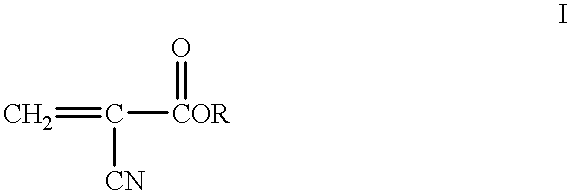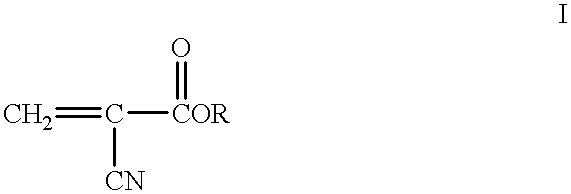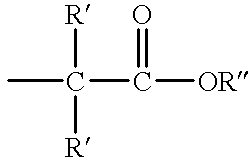Methods for sterilizing cyanoacrylate compositions
a technology of cyanoacrylate and composition, which is applied in the direction of disinfection, lavatory sanitory, water installation, etc., can solve the problems of unsuitable or undesirable conventional sterilization techniques, unsuitable solid compositions for use as adhesives, etc., to achieve the effect of solidification of cyanoacrylate ester compositions at low temperatures, and not practical for industrial production
- Summary
- Abstract
- Description
- Claims
- Application Information
AI Technical Summary
Problems solved by technology
Method used
Image
Examples
example 1
Sterilization of Liquid Cyanoacrylate Prepolymer Compositions
This example illustrates the electron (E) Beam sterilization of a liquid cyanoacrylate composition to a sterility assurance level of 10.sup.-6 wherein the sterilized composition does not solidify or forms a gel.
Specifically, in a class 10,000 clean room, 1.0 cc capacity high density polyethylene ampules were each filled with 0.5 cc of a liquid cyanoacrylate composition via a Watson-Marlow peristaltic pump fitted with silicone tubing. The cyanoacrylate composition comprised n-butyl cyanoacrylate (99.0+% purity), about 150 ppm of hydroquinone as a free radical polymerization inhibitor and 500 ppm of sulfur dioxide as an acid polymerization inhibitor. Water content and free formaldehyde were kept below 500 ppm in the composition. Bioburden was measured to be less than 1 CFU.
After filling the ampule, the open end of the ampule was heat sealed. The ampule was then placed into a 2 mil poly / foil / poly pouch and the pouch heat seal...
PUM
| Property | Measurement | Unit |
|---|---|---|
| pore size | aaaaa | aaaaa |
| temperatures | aaaaa | aaaaa |
| temperatures | aaaaa | aaaaa |
Abstract
Description
Claims
Application Information
 Login to View More
Login to View More - R&D
- Intellectual Property
- Life Sciences
- Materials
- Tech Scout
- Unparalleled Data Quality
- Higher Quality Content
- 60% Fewer Hallucinations
Browse by: Latest US Patents, China's latest patents, Technical Efficacy Thesaurus, Application Domain, Technology Topic, Popular Technical Reports.
© 2025 PatSnap. All rights reserved.Legal|Privacy policy|Modern Slavery Act Transparency Statement|Sitemap|About US| Contact US: help@patsnap.com



